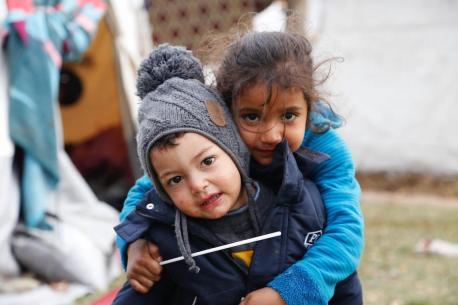Horn of Africa famine: one year later
One year ago, a humanitarian crisis was taking place in the Horn of Africa. Two million children were at the risk of dying of starvation, and on July 20, 2011 the United Nations declared famine in parts of Somalia. Thanks to the generous support from donors and sponsors, 1 million children have been treated for malnutrition in the region. On this anniversary we wanted to go beyond just the numbers and get a more personal perspective on the situation. So I sat down with Lisa Szarkowski, Vice President of Public Advocacy and Strategic Communications for the U.S. Fund for UNICEF, who had been in the region during the crisis. Lisa told me some very moving stories of the on-ground situation and the work that UNICEF does.
One year ago, a humanitarian crisis was taking place in the Horn of Africa. Two million children were at the risk of dying of starvation, and on July 20, 2011 the United Nations declared famine in parts of Somalia. Famine is declared when more than 30% of children suffer from acute malnutrition, more than 2 people out of a thousand die per day, and people do not have access to food and other basic necessities. Thanks to the generous support from donors and sponsors, 1 million children have been treated for malnutrition in the region.

On this anniversary we wanted to go beyond just the numbers and get a more personal perspective on the situation. So I sat down with Lisa Szarkowski, Vice President of Public Advocacy and Strategic Communications for the U.S. Fund for UNICEF, who had been in the region during the crisis. Lisa told me some very moving stories of the on-ground situation and the work that UNICEF does. In the summer of 2011 Lisa was stationed at UNICEF regional headquarters in Kenya, one of the four countries affected by the crisis in the Horn. During her stay, Lisa travelled to the Dadaab refugee camp in north Kenya. Here she witnessed the incredible hardships that people in the region have to overcome. Dadaab is actually three camps that together make up the world’s largest refugee camp, home to almost half a million people. Typically, refugees from neighboring Somalia will walk for days or even weeks to reach the Kenyan border. At the border they are admitted into Kenya as refugees and then must walk another 45 miles to get to Dadaab. On their arrival, families receive a small kit that includes a tarp and a cooking pot, and are assigned a spot in the camp. UNICEF assesses the arriving children’s health, and if needed admits children and mothers into one of three health center tents.

Aden waits with his grandmother and father on the day of his release from the hospital after being treated for severe acute malnutrition. © UNICEF Kenya/2011/Tidey
At the camp, Lisa met a three-year-old boy named Aden. He and his family had travelled on foot for 25 days to reach the camp in Dadaab. During the long walk, his mother died. His father, Abdile, continued, carrying three of his four children. At the nutrition stabilization center, Abdile never left his son’s side. When Lisa went to visit the little boy, it was too painful for Aden to even lift his arm, so Lisa stroked his feet to comfort him. During our conversation, Lisa also spoke about UNICEF’s emergency response to a crisis, as well as long-term risk reduction. UNICEF’s objective is “to keep a childhood intact”—to make sure that children reach the milestones necessary for their healthy development. UNICEF’S interventions in refugee camps can be life-changing. Many children receive immunizations or attend school for the first time. UNICEF works towards long-term solutions as well. In Ethiopia, UNICEF worked with the government to extend the country’s health extension program, which includes establishing simple outposts close to a village. A health post like this is a life-line: with simple tools like a scale and armbands UNICEF can monitor children’s growth in a region, and make sure their needs are being met. Health workers at such health posts use cell phones to quickly receive test results or ask a physician for medical advice. Speaking with Lisa brought the situation in the Horn of Africa to life for me, and underscored once more how necessary it is for UNICEF and partners to continue their work there. The famine has ended, yet 8 million people in the Horn of Africa still need humanitarian assistance. With the most recent rainfalls still being below average, the food insecurity continues. Children have been especially hard-hit in conflict-stricken Somalia: Over half a million children are internally displaced, children are at risk of being recruited as child soldiers, and in the south, acute malnourishment is still at emergency levels. UNICEF needs $273 million this year for providing humanitarian aid and to implement long-term solutions in the Horn of Africa. A year later, the famine in the Horn of Africa has ended—but the crisis continues. And so does UNICEF’s work there. For more information about the crisis, visit our Horn of Africa page.


